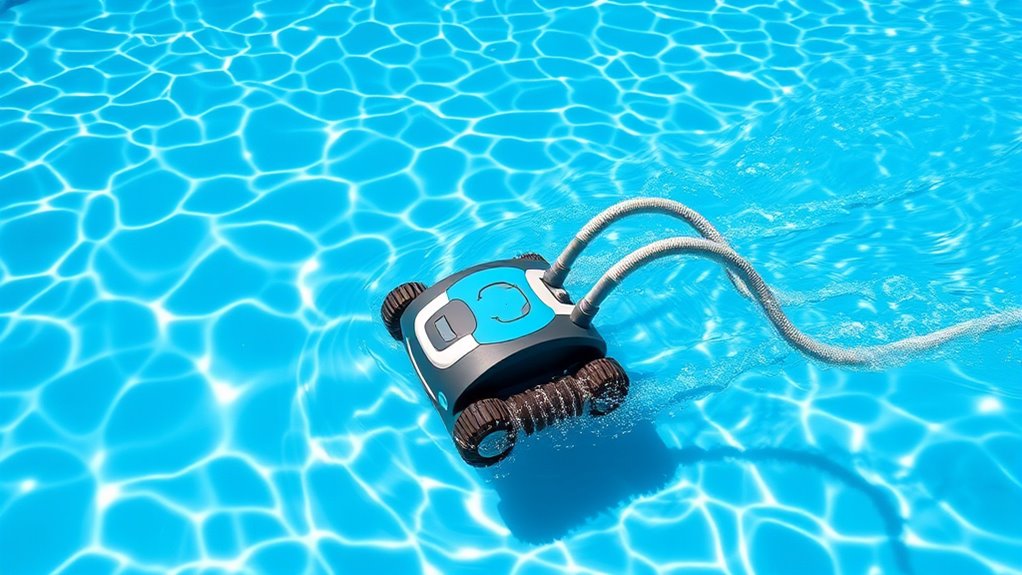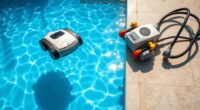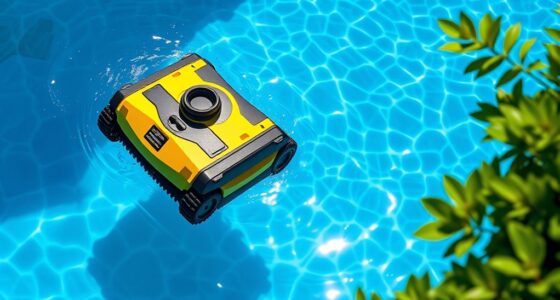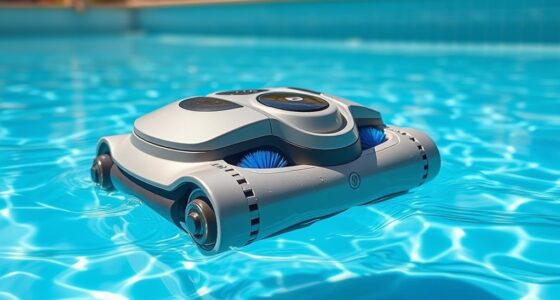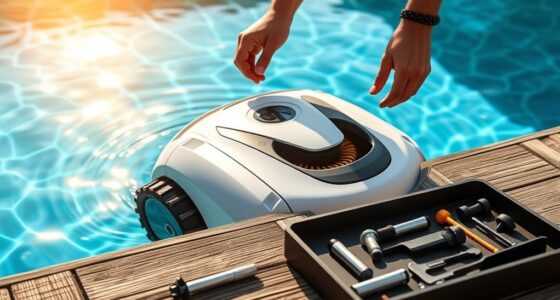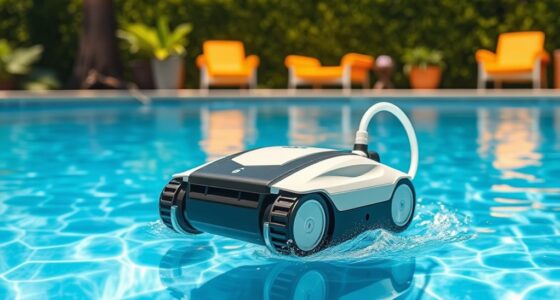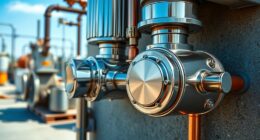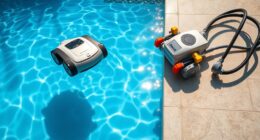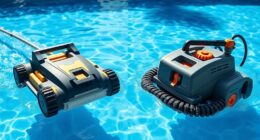Pressure pool cleaners work by using water pressure from your pool’s circulation system to move and collect debris. Water flows through hoses connected to the return line and is directed by a diverter valve, powering the cleaner’s jets and movement mechanisms. As the cleaner navigates the pool’s surfaces, it captures dirt in filters and uses water pressure to climb walls and reach corners. To discover how all these parts work together, keep exploring this guide.
Key Takeaways
- Water from the pool pump flows through hoses powered by high pressure to drive the cleaner’s movement.
- Water jets and internal gears use this pressure to propel the cleaner across pool surfaces and walls.
- The diverter valve directs water flow and connects hoses to ensure proper circulation and cleaning coverage.
- Debris is captured in filters or cartridges during circulation, maintaining water clarity and preventing recirculation.
- Proper system maintenance, including hose connections and filter cleaning, ensures optimal pressure and cleaning efficiency.
The Basic Components of Pressure Pool Cleaners
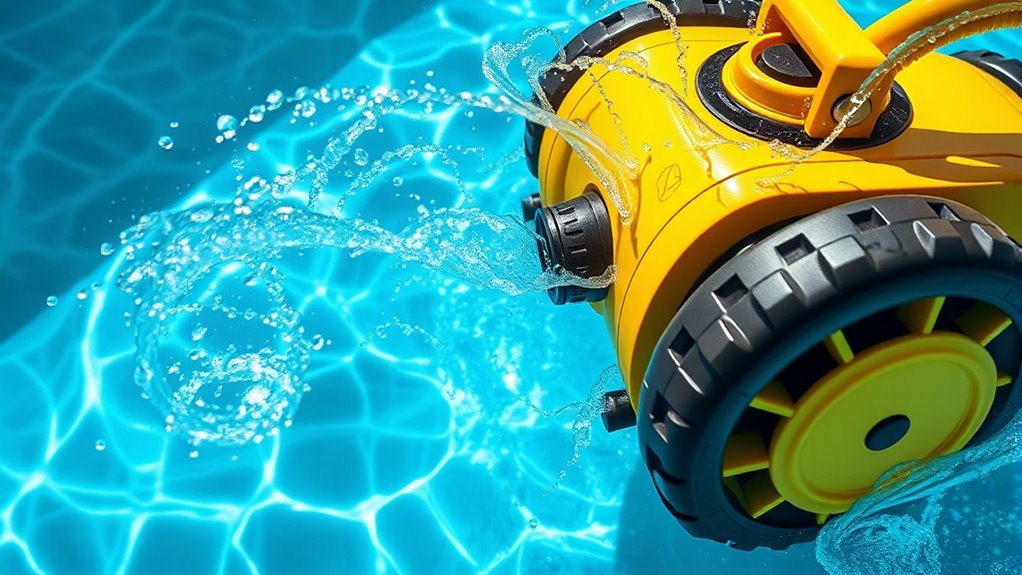
Have you ever wondered what makes pressure pool cleaners so effective? It all starts with their basic components. These cleaners typically include a hose, a turbine or venturi system, and a float assembly. The hose connects to your pool’s skimmer or dedicated pressure line, directing water flow. The turbine or venturi uses water pressure to generate movement, powering the cleaner across the pool surface. The float assembly helps guide the cleaner smoothly around the pool. Because pressure pool cleaners rely on existing water pressure, they’re designed to be energy-efficient, reducing overall pool maintenance costs. Their simple yet effective design ensures consistent cleaning without wasting electricity or water, making them a popular choice for maintaining clean, healthy pools efficiently. Additionally, many models incorporate automatic navigation features to improve coverage and cleaning efficiency, leveraging advanced navigation technology to optimize cleaning paths. The reliance on water pressure also means fewer moving parts, which can decrease the likelihood of breakdowns and extend the lifespan of the cleaner. This reliance on water pressure makes them a low-maintenance and environmentally friendly cleaning solution, which further contributes to their popularity among pool owners.
How Water Pressure Powers the Cleaner
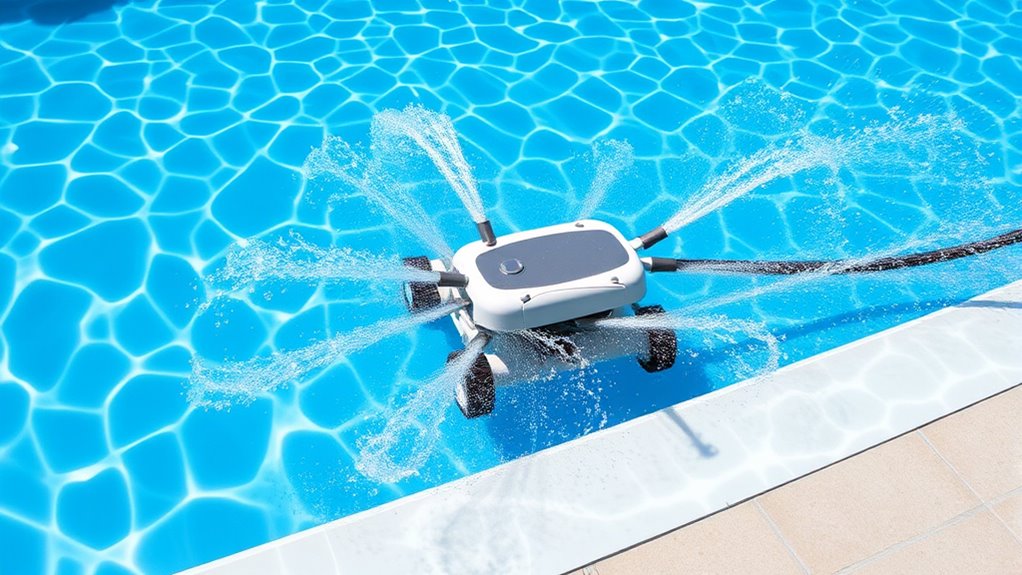
Water pressure is the driving force behind how pressure pool cleaners move and operate. When you turn on your pool’s pump, water flows through the hoses, creating high-pressure flow that powers the cleaner’s movement. This pressure lifts debris from the pool floor and walls, directing it into the filtration system. Maintaining proper pool chemistry is essential because imbalanced chemicals can affect water flow and cleaner efficiency. Proper water chemistry ensures optimal water flow, which is vital for the cleaner’s performance. Regularly inspecting hoses and fittings helps prevent leaks that can reduce pressure and hinder cleaning effectiveness. Additionally, understanding industry trends can help you choose the most efficient cleaner for your needs. Staying informed about new technologies can lead to improved efficiency and better cleaning results. Always follow safety precautions, such as disconnecting power when servicing the cleaner, to prevent accidents. The high-pressure water not only drives the cleaner but also ensures debris gets captured effectively, keeping your pool clean and clear. Understanding how water pressure works helps you optimize cleaner performance while keeping safety a priority.
The Role of the Diverter Valve and Hoses

The diverter valve and hoses work together to direct water flow efficiently within your pressure pool cleaner. The diverter valve controls the water’s path, switching between different hose connections to guarantee proper water distribution. When you set up the cleaner, you’ll connect hoses to specific ports, and the diverter valve manages which hose receives the pressurized water. This setup allows the cleaner to move and scrub the pool surfaces effectively. Proper hose connections are vital for ideal water flow, preventing leaks and maintaining pressure. The diverter valve’s role is essential in balancing water pressure, ensuring your cleaner works smoothly. By managing water flow precisely, these components help your pool cleaner perform efficiently and effectively.
Movement Mechanisms of the Cleaner
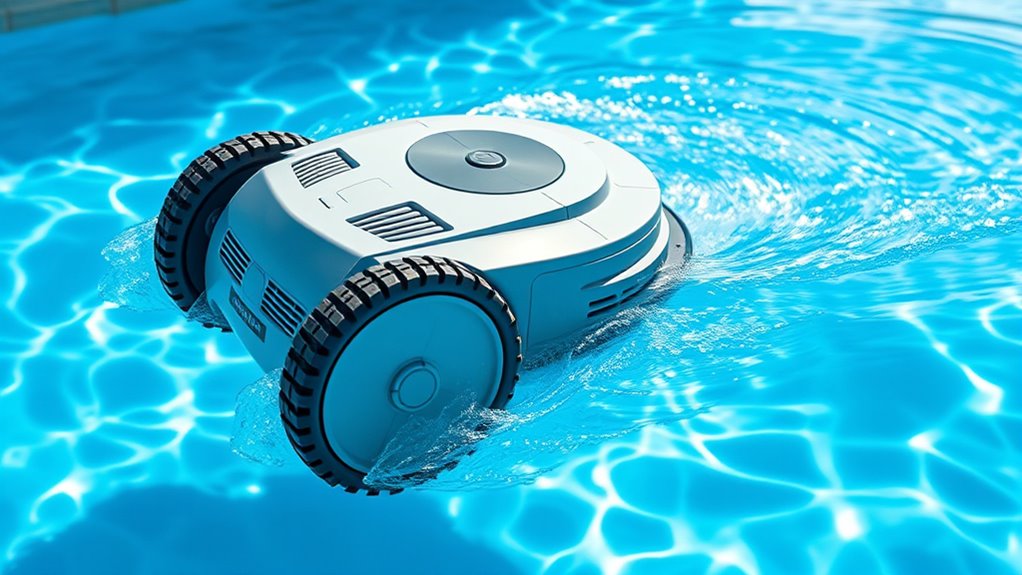
Pressure pool cleaners move across the pool surface by utilizing a combination of internal mechanisms and water power. They navigate efficiently, adjusting to different debris types like leaves, dirt, or algae. Their movement relies on water jets and internal gears that propel them forward, ensuring coverage of all pool areas. The cleaner’s design allows it to climb walls and reach corners, improving cleaning effectiveness. This efficient movement is achieved through a combination of propulsion techniques tailored to various pool shapes and sizes, enhancing overall performance. Understanding these movement mechanisms helps you optimize performance and troubleshoot issues. Here’s a quick overview:
| Movement Type | Key Feature | Effectiveness |
|---|---|---|
| Jet propulsion | Water jets push cleaner | Moves in straight lines |
| Gear drive | Internal gears rotate | Navigates around obstacles |
| Wall climbing | Special brushes or suction | Reaches pool edges |
| Surface adaptation | Flexible movement techniques allow the cleaner to adapt to various pool surfaces, enhancing overall efficiency. Additionally, surface type can influence the choice of cleaner for optimal results. |
Debris Collection and Filtration System

A pressure pool cleaner’s debris collection and filtration system work together to efficiently remove dirt, leaves, and algae from your pool. As water circulates, the cleaner captures debris in a mesh or cartridge filter, preventing clogs and maintaining peak flow. Proper pool chemical balance ensures the filtration system operates effectively, reducing algae buildup and keeping water clear. The design emphasizes user convenience by allowing easy access to filters for quick cleaning and maintenance, so you spend less time on upkeep. Additionally, a well-maintained filtration system helps prevent debris from recirculating, maintaining healthier water. Regular filter maintenance is crucial for optimal performance and longevity of your pool equipment. By choosing the right filtration technology, you can enhance the efficiency of your pool cleaning system. Proper filtration also plays a vital role in ensuring water quality, providing a safer swimming environment. Incorporating advanced filtration systems can further improve debris removal and water clarity. Overall, this system ensures your pool stays clean and inviting, with minimal effort on your part. Proper filtration is essential for maintaining water quality and prolonging your pool equipment’s lifespan.
Navigating Obstacles and Pool Surfaces
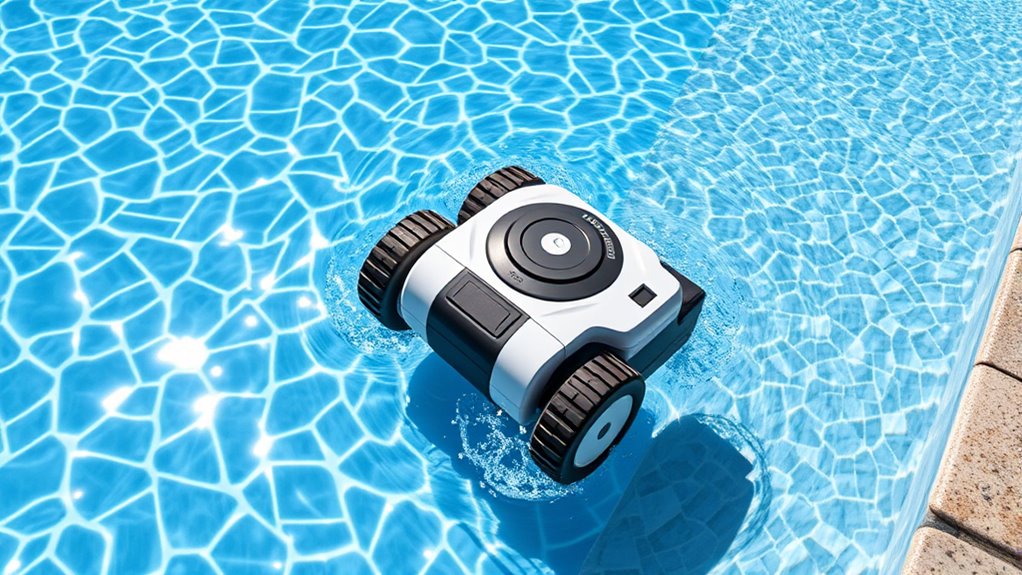
Handling obstacles and varied pool surfaces can challenge even the most advanced pressure pool cleaners. Different pool surface types—such as concrete, tile, or vinyl—require adaptable cleaning methods. Pressure cleaners excel at obstacle navigation, but their effectiveness depends on their design and your pool layout. To optimize performance, consider these key points:
- Adjust the cleaner’s settings for different surface textures
- Ensure the cleaner can handle tight corners and steps
- Regularly remove debris that may block obstacle pathways
- Selecting a pressure cleaner with customizable features can enhance its ability to adapt to different pool surfaces and obstacles. Additionally, choosing a model with adjustable pressure settings can improve cleaning efficiency across various surfaces. Employing a surface-specific brush can further improve cleaning results on delicate or textured surfaces, especially when combined with proper maintenance to keep the equipment functioning optimally.
The Connection to Your Pool’s Return Line
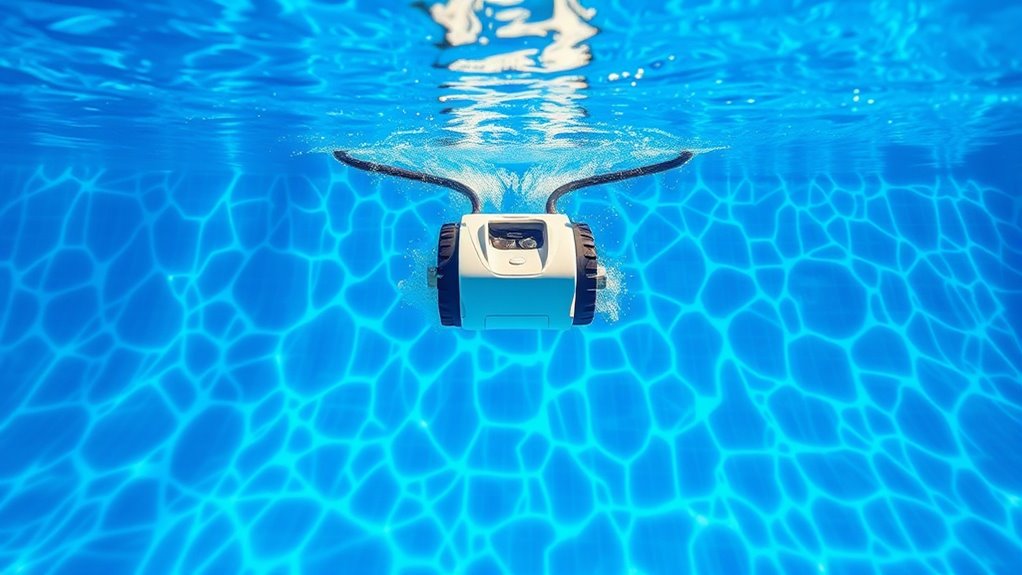
Connecting your pressure pool cleaner to the return line is a crucial step that directly impacts its cleaning efficiency. Proper attachment ensures the cleaner receives a steady flow of water, which powers its movement and suction. As water circulates through the return line, it helps maintain balanced pool chemistry, preventing issues like algae growth or cloudy water. Additionally, a secure connection allows the cleaner to operate effectively without wasting energy, reducing overall energy consumption. Make sure the hose fits snugly and that the connection isn’t blocked or leaking, as leaks can decrease pressure and cleaning power. Properly maintaining pool water circulation ensures optimal performance of your pressure cleaner. Regular inspections of the mechanic shops for fuel injection cleaning can help keep your pool’s filtration system in top shape, indirectly supporting efficient circulation. Improving system efficiency through proper maintenance can also enhance the overall effectiveness of your pool’s cleaning. When the system is well-tuned, it can also benefit from Honda Tuning principles by optimizing flow and efficiency. By ensuring a proper link to the return line, you optimize your pool’s cleaning performance while conserving energy and maintaining healthy pool chemistry.
Maintenance and Troubleshooting Tips
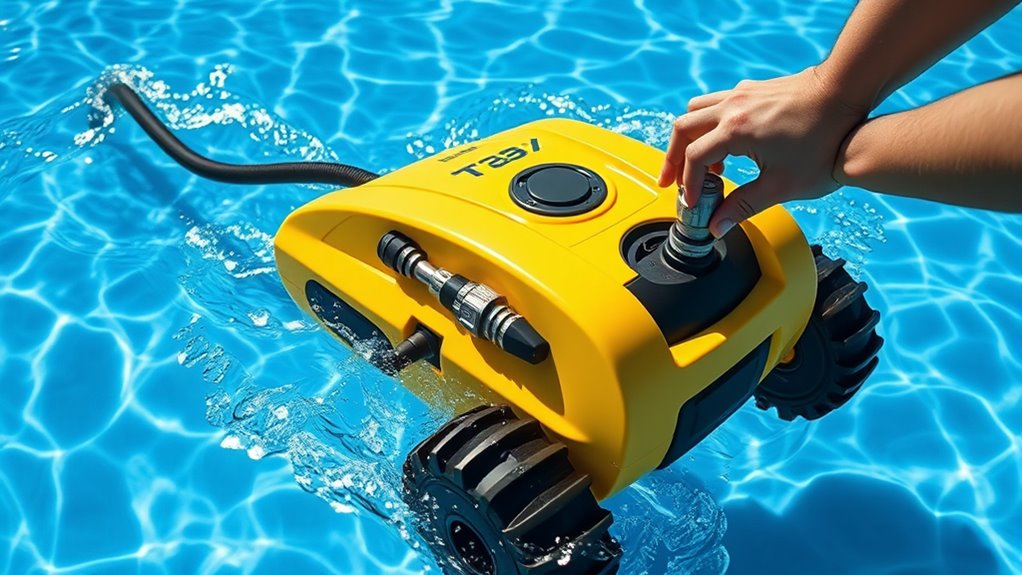
Regular maintenance and troubleshooting are key to keeping your pressure pool cleaner performing at its best. To guarantee peak cleaning, check the pool chemical balance regularly, as imbalances can affect the cleaner’s efficiency. Keep an eye on common issues like clogged hoses or debris buildup, which can hinder performance. Here are some tips to help you maintain your cleaner:
- Regularly inspect and clean the filter and hoses
- Maintain proper pool chemical balance for safe operation
- Follow pool safety tips to prevent accidents during maintenance
- Staying informed about automation in business can help you understand how technology continuously evolves to improve equipment performance. Additionally, considering the use of smart pool technology can further optimize your pool maintenance routines.
Benefits of Using Pressure Pool Cleaners

Using a pressure pool cleaner helps you remove debris quickly and thoroughly, keeping your pool cleaner and safer. It also cuts down on the manual effort needed, so you spend less time cleaning and more time enjoying your pool. Overall, it makes pool maintenance easier and more efficient.
Efficient Debris Removal
Pressure pool cleaners excel at removing debris quickly and thoroughly, saving you time and effort. They efficiently pick up leaves, dirt, and other particles, helping maintain your pool’s cleanliness. This rapid debris removal supports better pool chemistry, preventing imbalances caused by organic matter buildup. Plus, their design promotes energy efficiency, reducing long-term power costs.
Key benefits include:
- Fast removal of surface and bottom debris
- Consistent cleaning that minimizes chemical fluctuations
- Reduced overall energy consumption compared to manual cleaning
With pressure pool cleaners, you get a more effective cleaning process that keeps your pool sparkling and balanced, all while saving energy and maintaining optimal pool chemistry. This makes them a smart choice for effortless, efficient debris removal.
Reduced Manual Labor
Because they automate the debris removal process, pressure pool cleaners substantially reduce the manual effort needed to maintain your pool. You won’t have to spend hours skimming or scrubbing, freeing up your time for other activities. This automation also helps maintain proper pool chemical balance, as cleaner pools require fewer chemical adjustments. Additionally, pressure cleaners are energy-efficient, consuming less power compared to manual cleaning methods or robotic alternatives. By reducing your involvement, you’ll lower your energy consumption overall, making pool maintenance more affordable. With less manual labor, you can enjoy a consistently clean pool without the hassle, ensuring your pool stays inviting and balanced with minimal effort.
Frequently Asked Questions
Can Pressure Pool Cleaners Clean Algae and Bacteria Effectively?
Pressure pool cleaners can effectively handle algae removal and bacteria elimination. They use high-pressure jets to scrub and vacuum debris, algae, and bacteria from your pool surfaces. As you operate the cleaner, it dislodges algae and bacteria, making them easier to filter out. This active cleaning process helps keep your pool hygienic and clear. Just guarantee your pool’s chemical balance is maintained, and the cleaner will do a great job.
Are Pressure Pool Cleaners Suitable for All Types of Pools?
You might wonder if pressure pool cleaners suit your pool, and it depends on factors like pool size and surface material. Larger pools benefit from their efficiency, while smaller ones might find them overkill. They work well on concrete, plaster, and vinyl surfaces, but may struggle with delicate materials like fiberglass. Consider your pool’s size and surface to determine if a pressure cleaner is the right fit for maintaining cleanliness effectively.
How Long Does It Typically Take to Clean a Pool With One?
The pool cleaning duration with a pressure cleaner usually takes about 1 to 3 hours, depending on factors like pool size, debris level, and cleaner efficiency. Larger pools or heavy debris can extend cleaning time, while smaller, cleaner pools may take less. You can expect consistent results within this timeframe, but cleaning time factors like pool shape and water conditions also influence the overall duration.
Do Pressure Pool Cleaners Consume a Lot of Energy?
You’re wondering if pressure pool cleaners use a lot of energy. They generally have moderate energy consumption, making them efficient for regular cleaning. While they do use some power, their efficiency considerations mean they don’t drain your energy resources excessively. If you’re mindful of energy use, these cleaners offer a good balance between effective cleaning and conserving power, especially compared to more manual or energy-intensive options.
Can Pressure Cleaners Be Used During Pool Swimming Hours?
You can use pressure pool cleaners during swimming hours, but you should consider pool safety and operational noise. These cleaners often produce some noise, which might disturb swimmers, and the suction power could pose safety concerns if not monitored. To guarantee a safe and enjoyable swimming experience, it’s best to schedule cleaning when the pool isn’t in use or choose quieter models designed for minimal disturbance.
Conclusion
Now that you understand how pressure pool cleaners work, you might think they’re complicated or unreliable. But with proper maintenance and understanding, they’re simple to operate and highly effective at keeping your pool spotless. Don’t let tech concerns hold you back—these cleaners save you time and effort, making pool upkeep easier. Give one a try, and enjoy sparkling clean water without the hassle of manual cleaning!
